Lithops Karasmontana is one of the most attractive low growing lithops or stone plant species. You could spot them usually forming in clumps and they really look like small pebbles (or stone).
Their leaves are unique to them as you could spot them in grey to brown and in a mottled appearance. Lithops Karasmontana generally produces stunning flowers too.
You could easily maintain these plants and you only need to make sure that you provide only the basic requirements of them. Lithops Karasmontana are native plants in Namibia and in South Africa as well.
Nicholas Edward Brown described this species for the first-time way back in 1926. They have inherited this name from the Great Karas Mountains of Namibia.
You could spot them growing in barren mineral plains and even in mountain slopes in those areas too.
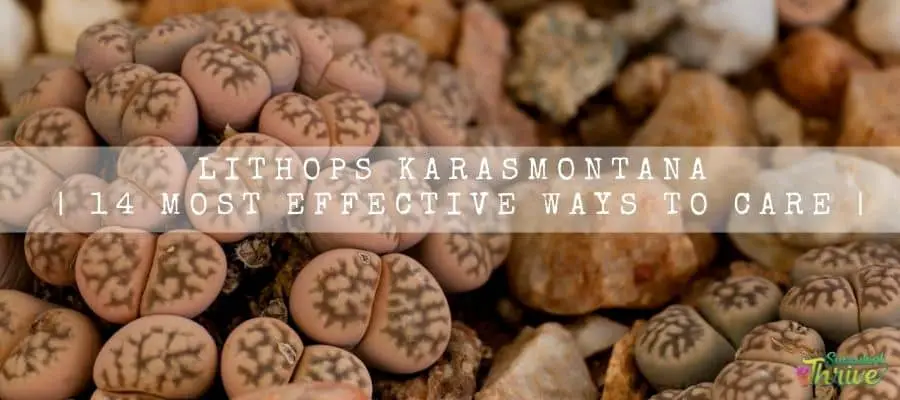
How do I identify lithops karasmontana?
You may identify the Lithops Karasmontana from several features such as from their foliage and from their flowering activity.
As aforesaid the leaves of the wild Lithops Karasmontana usually are gray to brown. But there can be wide color variation depending on their location. Lithops Karasmontana grows stemless, and it is a perennial succulent type.
They would consist of a pair of leaves which are usually plump which resemble two really close stones. Those leaves have stone-like markings.
Lithops Karasmontana flowering activity would also help you to identify these plants. Usually, they would produce flowers in white.
Moreover, they would consist of a yellow center as well. You identify them from flowering during Autumn or in Winter.
Size of the plant
Lithops Karasmontana would rise to 2 inches. Further they would be about 2 inches in width.
One look care guide
| Botanical Name | Lithops Karasmontana |
| Common Name | Karas Mountains Living Stone |
| Plant Type | Succulent |
| Mature Size | 2 inches in height / 2 inches in width. |
| Sun Exposure | Full Sunlight to Partial sunlight |
| Soil Type | Sandy, well-draining |
| Soil pH | Around 6 |
| Bloom Time | Autumn or winter |
| Flower Color | White / yellow centers |
| Hardiness Zones | USDA hardiness zones 9b-11b. |
| Native Area | Namibia / South Africa |
| Toxicity | Non-Toxic |
| Average price | 10 USD |
How do you take care of lithops karasmontana?
Lithops Karasmontana could perform well if you make sure that you fulfill the right growing conditions for them.
Light Requirement
Lithops Karasmontana would perform well, if they can gain full sunlight. You could grow them in a greenhouse if you wish.
Unless you may grow them indoors and a bright sunny windowsill will suit them the best. It should ideally be a windowsill where they can gain direct sunlight for about 4-6 hours during morning hours. They could survive in partial shade during afternoon hours.
Having said that, you need to ensure that you are slowly acclimating these plants to bright sunlight without exposing them to bright sunlight at once.
If you do so unintentionally that could lead the plant to have sun burns. Further chances are that they could get traumatized.
To overcome this, you may even use a shade cloth. If you grow Lithops Karasmontana in strong lighting levels, they could grow much resistant to damage and rot.
If you keep growing them under low lighting levels, that will make these plants more vulnerable for rotting and for fungal infections as well.
As such it is mandatory that you grow these plants in proper lighting levels as consequently that will help them to become more vibrant in their colors.
In addition to that, lack of sunlight will make the plants etiolated and make them slender too.
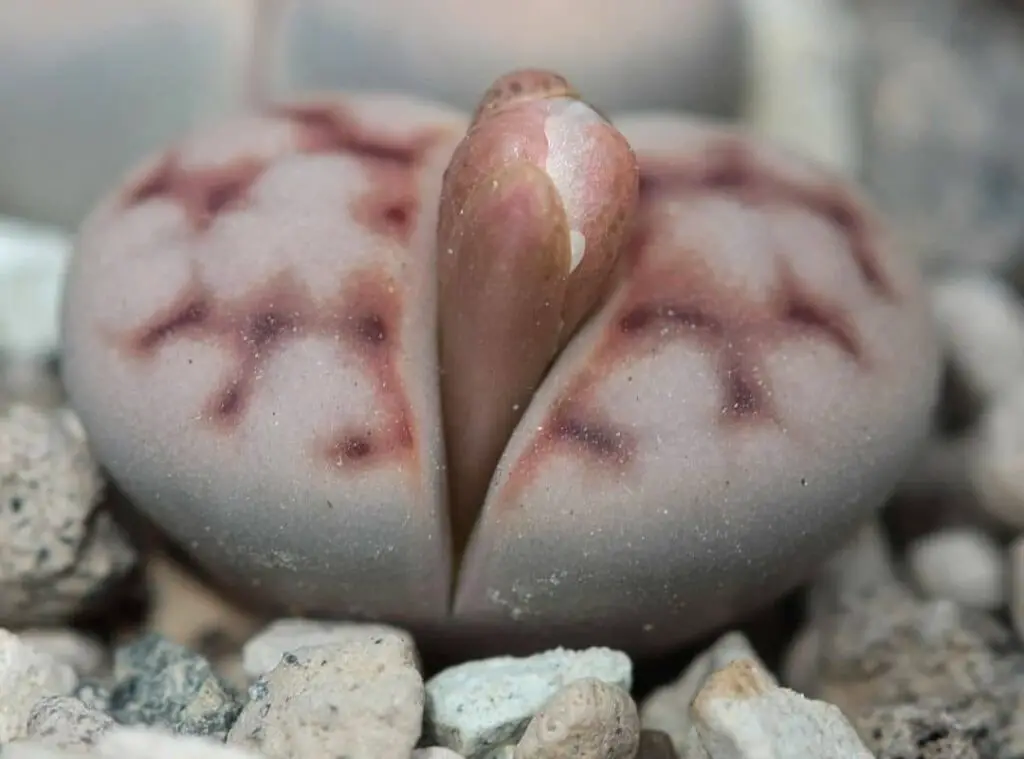
Temperature and humidity
Lithops Karasmontana would prefer to have a temperature range of 25 degrees Celsius – 30 degrees Celsius during the daytime of the summer.
On the other hand, they could thrive well at a night temperature of 15-20 degrees Celsius during summer.
If you expose them to temperatures more than 30 degrees Celsius for prolonged periods, they will tend to look like they are lethargic.
You need to make sure that there is a good air flow around these plants.That will help to avoid any potential scorching in the plants.
They could thrive in a minimum temperature of 4-8 degrees Celsius during winter. Keep in mind that you should not allow them to expose themselves to frost conditions at any given point of time.
Is it cold hardy ?
Lithops Karasmontana are not frost hardy plants as many other succulents. Hence, you need to protect them from the extreme winter conditions.
USDA Hardiness Zone
Lithops Karasmontana would prefer to grow in USDA hardiness zones 9b-11b.
Watering Requirement
Lithops Karasmontana would thrive well if you water them properly. You need to water them only during certain stages and on the other hand you need to cease watering and keep them dry during some stages.
Just like with the other succulents, over watering could harm these plants also and cause them to perish.
If you provide water in abundance that would consequently lead Lithops Karasmontana to rot.
On the other hand, if you do not provide adequate water that would make the plants go through a stunt growth.
The frequency of watering could vary on the potting medium withering pattern and on the season as well.
Having said that, when you water them ensure that you water them thoroughly and then let them dry entirely. If the soil is dry, you could start watering them.
Ideally you could cease watering until they show symptoms of under watering. if you come across such situations, they can revive with one or two drinks of water.
However, when you water, ensure that you water them during morning hours. That will allow the Lithops Karasmontana plants to have a proper evaporation as the day progresses.
Further, less moisture will also be retained in the roots as a consequence of this.
Best is to keep them dry during winter and you could consider watering them only when you spot them forming wrinkled leaves.
You could lightly water them during fall. Lithops Karasmontana would go dormant during summer.
As such you need to leave them to be in dry conditions all the time. On the other hand, if you grow these plants in tropical countries, they could grow well in winter whilst having a longer dormant season in summer.
When they are in their dormancy, they tend to shrivel their leaves and a new pair of leaves will arise within the old leaves.
As such you need to skip watering until you spot the old leaves fully dried. In case if you end up watering the older leaves, they will tend to resume growing up again and it will stop the new leaves forming.
Ultimately the plant’s overall growth will be affected by this in an unhealthy manner.
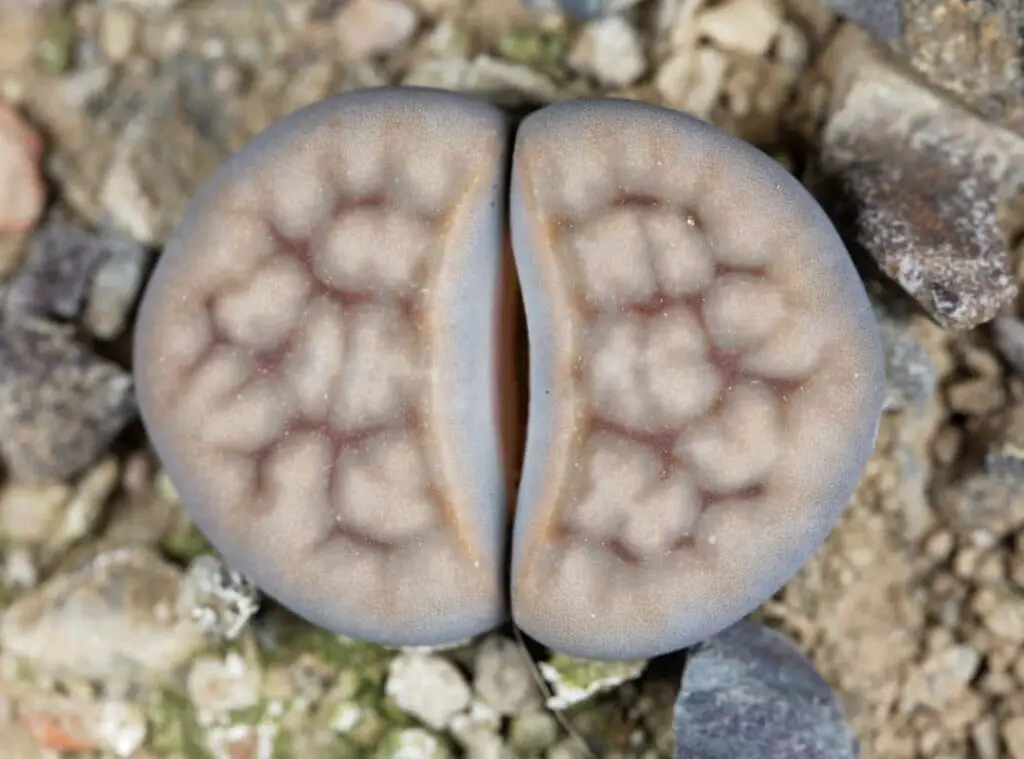
Soil Requirement Type / pH
Succulents in general need to have a well draining soil mix. Lithops Karasmontana is no different to them and it is important that you also grow them in a soil mix which has excellent drainage.
Lithops Karasmontana would perform well in a potting medium which consists of coarse sand.
if you fail to provide a well draining soil mix, that will make the plants vulnerable for so many diseases including root rot.
I recommend using elements such as coarse sand, perlite, decomposed granite or even other gritty substances would be quite useful here to enhance the draining of the soil mix, given that you are using a regular soil mix.
Easiest is to proceed with a special cactus soil mix or a succulent soil mix.
Flowering and Fragrance
Lithops Karasmontana produced blooms in white as explained in the beginning of the article. Those flowers would further consist of a center in yellow too.
Lithops Karasmontana blooms would be about 4-5 cm in radius. Further the flowers would arise between two sections of foliage whilst forming upright and splitting them in two.
The flowering season of these plants would be Autumn or Winter.
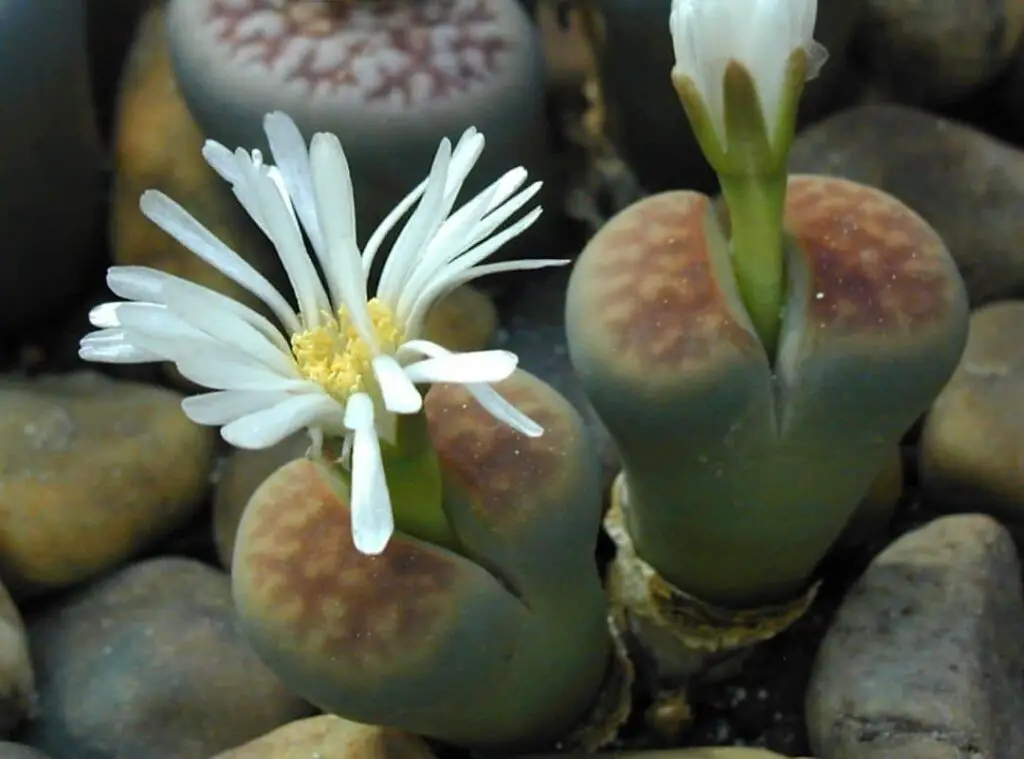
Pot size Potting and Repotting
Lithops Karasmontana root system would tend to spread in an extensive manner. This literally means, you need to grow them in a pot which is somewhat larger than the plant size.
Having said that, do not go ahead and use way too large pots to grow the Lithops Karasmontana plants as then there will be excess moisture retained in the pot and lead to root rot.
To pot them, you need to first obtain a pot which is somewhat larger than the Lithops Karasmontana root system.
Ideally the pot depth should be two sizes of the plant’s root system. Moreover, ensure that your pot has a draining hole in the bottom as well.
Secondly you could place some mesh on the draining hole so that the potting medium will not split from the pot.
Thirdly, get some well-draining cactus and succulent soil mix and fill the pot half with the potting medium. Make sure you mix the extra draining substance also mixed in the soil mix.
Fourthly I recommend adding a slow-release fertilizer also on the soil medium.
Finally, you could plant it in the container and keep adding more potting medium and ensure that the plant is well established in the potting medium.
Do not water the specimen for about 7-10 days and after that you may resume watering them.
In terms of repotting them, the best recommendation is to conduct it in either spring or in autumn. However, ensure that you do it prior to watering them.
Where to Plant
You could plant them in a greenhouse. If you grow them as houseplants, a bright sunny windowsill would be a perfect place to locate these plants.
Fertilizer and time of year
Lithops Karasmontana generally grows in their habitats in low quality soil mix which does not have a lot of nutrients.
Hence, you do not really have to feed them heavily. You need to be mindful to avoid over feeding them as it could lead to the health deterioration of the plants.
Apart from that, you need to go ahead with a fertilizer which has a low amount of nitrogen. Feeding them would help these plants to produce vigorous blooms as well.
Dormancy
Lithops Karasmontana goes into dormancy during late summer. During their dormancy you need to avoid watering and feeding them.
Can be toxic to pets
Lithops Karasmontana are not poisonous for both humans as well as for pets. Hence you could have them if you have pets or even small kids at your home.
Common bugs and illnesses
Lithops Karasmontana may come across pests’ attacks particularly from spider mites a lot. In addition to that, thrips, scales, mealybugs, aphids could also invade them.
Also bugs, snails, slugs, and root knot nematodes could be so invasive for them. Moreover, mice and some other animals’ species may also consume the parts of plants.
In addition to that, over watering may cause root rot and it could be so dangerous since it could even kill the plants.
Special Care tips
Lithops Karasmontana are relatively easy to care. All you have to do is to water them properly, expose them to adequate sunlight levels and grow them in a well-draining soil mix.
As long as you fulfil these necessities Lithops Karasmontana could perform well.
Further I urge you to conduct constant check ups on your plants so that you could see whether your Lithops Karasmontana are growing healthy or whether there are any early signs of any disease.
The sooner you identify these issues, the better it would be.
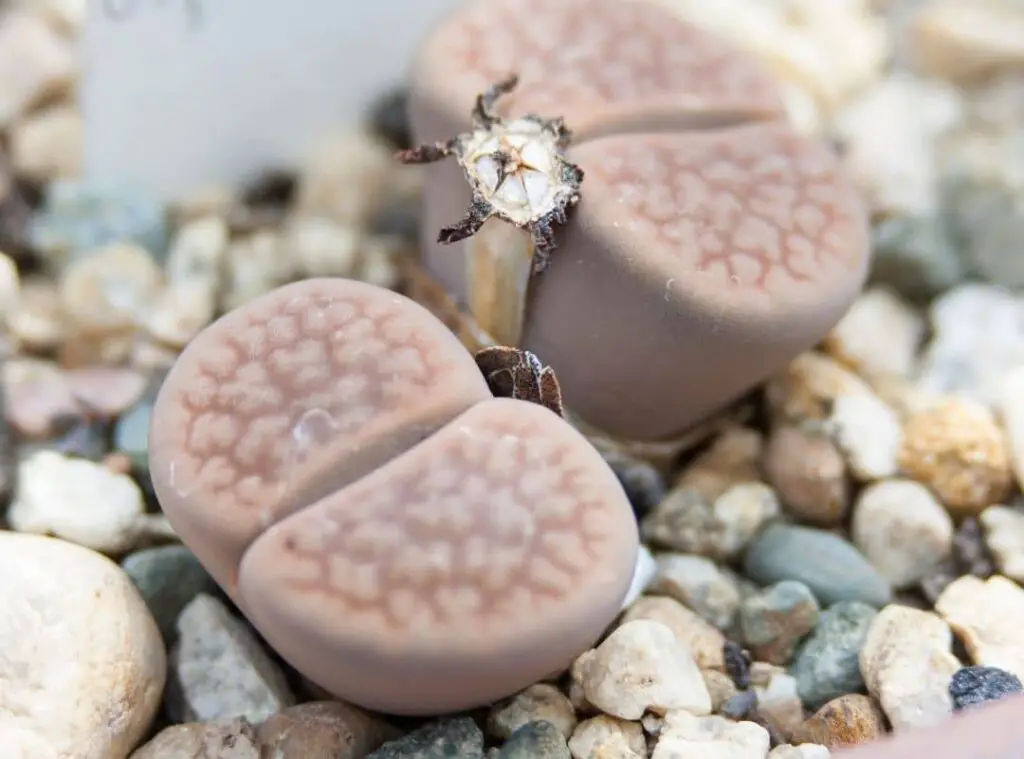
How to propagate lithops karasmontana
You may use either seeds or cuttings to propagate these plants. If you use the cuttings, you need to wait until the plants naturally divide to form multiple heads.
As such many people tend to use seeds to propagate the Lithops Karasmontana plants.
You could have faster results if you use their seeds for the propagation and chances are that they could bloom within 3-4 years also given that they get the right growing conditions to grow.
You simply have to sow the seeds in a sandy medium during summer and cover them with a sand layer.
You could consider watering them so that the seeds won’t be displaced. After that you could locate them in a warm sunny place and keep the specimen moist.
You will see the germination of the first seeds within a few weeks’ time. Further when you spot the seedlings tend to grow faster, you could minimize watering them.
When the plants are 2-3 months old, you could water them. However before you water them you need to always check whether the soil is dry from its previous watering session.
You could consider replanting them when they are a little older.
Conclusion
To sum up what we discussed above, Lithops Karasmontana are some stunning sets of plants which would be so lovely to have at your home.
All you need to do is to take care of them well so that they can grow well. These facts would have made you so excited to have one of these plants.
So why wait, hurry up and start growing these wonderful plants.
Read Next : Pleiospilos Nelii Succulent Care | 15 Awesome Facts |
Read Next : 17 Conophytum Bilobum (living pebble) Care Secrets For You
